Choosing and gluing stained glass film

When creating an original interior, a wide variety of materials are used. Many are especially attracted by stained glass film (in another way it is called "dacron", "lavsan", "sterile"). Buyers love it for its cost and intricacy. By applying a bright window coating that mimics colored glass, you can create a stunning, original design, transforming the interior as a whole.
Wherein you can be sure that the product will last a long time, because this coating is polyamide, it dries quickly, is durable, does not rub. Today there is a wide selection of such canvases, conditionally subdivided into types. Everything is described in detail in the article.

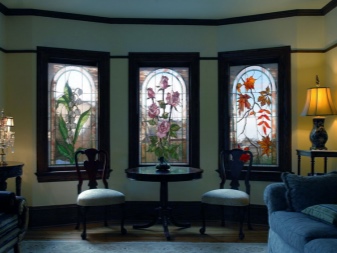
What it is?
Stained glass film is a rather interesting material that is readily applied to glass: on mirrors, on lamps, on windows and other similar objects. The material helps to block out the rays of the scorching sun, which often causes fatigue and heating of the space. Film stained glass gives the room a shadow and removes visibility through the glass. After applying it to the surface, the appearance of the room is significantly transformed, in addition, the service life of the windows increases.

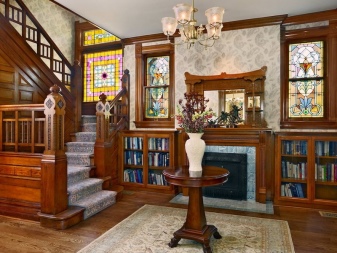


During production, glue is added to the film, so there will be no problems when gluing. The variety of stained glass products opens up a wide scope for use.
Main varieties
The result depends on what kind of film was used in decorative or finishing work. There are several options that you need to thoroughly familiarize yourself with.

Vinyl
Vinyl products are special films made from high quality synthetic polymer - polyvinyl chloride. This option is considered the most budgetary. Plastic is used everywhere: it is used to make body decorative stickers on a car, create wallpapers with pictures, and much more.

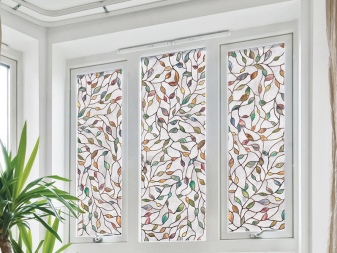
Pros:
- price - vinyl is a very budget and popular option;
- appearance - the buyer is offered a wide choice, the vinyl film looks incredibly beautiful and comes in any variety, with different patterns, for example, with flowers.

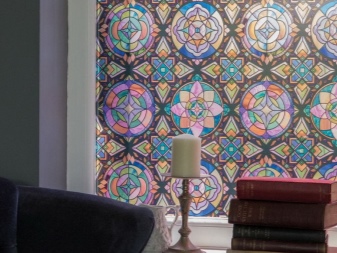
Minuses:
- fragility - after a few years, the product will have to be changed, since it loses its original appearance;
- distortion - vinyl makes the view from the window distorted;
- complexity of maintenance - special gentle agents are required for vinyl;
- difficulties in gluing - the film is light, therefore it is rather difficult to paste over anything with it, and bubbles often remain.

Polyester
Polyester materials are super transparent, very durable, but they have poor sliding properties. Plastic is widespread in construction; fabrics, fillers and more are made from it. At the same time, the quality of polyester film is better than that of vinyl.


Pros:
- stability - the product is resistant to temperature extremes, in addition, it is almost impossible to tear it;
- durability - many manufacturers promise that the film will last at least 25 years;
- appearance - polyester film is bright, it includes different shades, in addition, the image through glass is seen without distortion.


Minuses:
- price - polyester film is more expensive than budget vinyl.

Sunscreen
As you might guess from the name, a sunscreen product is designed to protect the room from the scorching sun.It is especially important in the heat and for those apartments with windows facing south. This film is popular because it fights heat effectively.


Pros:
- protects from the sun - a sunscreen product prevents the sun's rays from entering the room, so you can do without curtains;
- quick repair - if you follow the instructions, the product can be glued to the window quickly and without bubbles.


Minuses:
- burnout - the product burns out over time;
- bubbles - in order for them not to appear, you need to try hard when pasting windows.

Self-adhesive
Self-adhesive tape includes vinyl or other plastic wrap with decorative designs such as flowers, patterns. This material has durability, as well as unlimited possibilities: the realization of design fantasies, a wide range of applications.


Pros:
- versatility - self-adhesive products can be used on almost any surface, such as plastic, glass, mirror, something else;
- wide choice - manufacturers offer a variety of film options suitable for creating comfort in the house, for pasting windows, furniture, and other items.



Minuses:
- the complexity of gluing - before starting work, you need to carefully prepare the surface, while not every person copes with this stage;
- limited term of use - after 3 years, the product needs to be changed.


Design options
The material can be made in the form of an imitation of a colored stained-glass window or be light and have an openwork pattern - it all depends on the intended style. Thanks to the special Mylar polyethylene, the film adheres well to the surface, therefore it is often used for the stained glass effect, creating a truly magnificent interior design.



There are a lot of types of canvas, and designers advise using each of them wisely. A matte film, for example, is ideal for doors made of glass. Colored and patterned - they look attractive on windows. Light films with an unobtrusive print can transform boring mirrors, making them real interior decorations.



Stained glass film with a pattern flaunting on it, as a rule, is waterproof, so it is readily used in the bathroom, while a light-colored coating looks great on the doors of shower cabins. Designers also like to decorate wooden doors with decorative film - this design allows you to create a compositional style.



Mosaic is one of the brightest representatives of the film. It consists of miniature rectangles, ovals or rhombuses. A variety of shapes, colors opens up opportunities for a person to fly imagination while creating a unique interior. As for the transparent film, it is mainly glued to the table to keep the surface in perfect condition.


It is practically invisible, does not obscure the color and surface pattern.
How to choose?
Before buying a budget coating for glass surfaces, it is advisable to understand the characteristics, pros and cons of the product (it has already been written about them above), and it is also worth considering a few nuances.
- Film quality - upon purchase, the buyer must have the opportunity to inspect the product. Any specks, dull color, especially the presence of bubbles, indicate a poor-quality product.
- Quality assurance - a certificate proving quality must be available. If they refuse to show it, there is a chance to buy a bad product.


Now everyone has mobile phones at hand, while in the store, it is necessary to study consumer reviews about the product you like - this will help you not to make a mistake when choosing. In addition, you can look at photographs of already pasted films to estimate whether the product will fit into the interior.
The types of films should be chosen in accordance with the style of the home.
- Transparent stained glass window. It meets the requirements of three styles at once: Scandinavian, Baroque and minimalism.There may be pictures on the film, which makes it even more interesting. Geometric patterns are suitable for Scandinavian style, pale tones for minimalism, and patterned film will look great in the Baroque style.


- Frosted stained-glass window. Such a product will perfectly fit into the minimalism or kitsch style. Matte film has a variety of choices: it includes different colors and, as a rule, interesting patterns. After gluing it, the glass becomes much stronger. If you choose a matte finish with a pattern, then it will add charm to the interior.
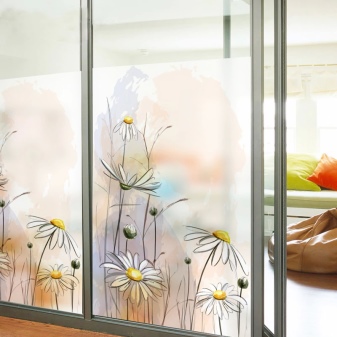
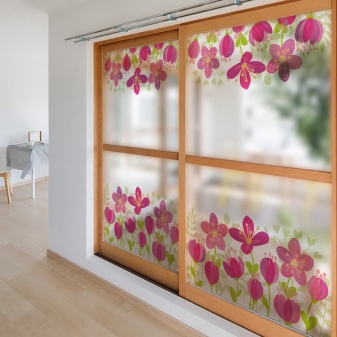
- Monochromatic stained-glass window. It looks appropriate in the style of minimalism, but it may look uninteresting if there are no bright elements in the interior. A monochromatic film will harmoniously fit in if it fits the concept. It all depends on the correct application.
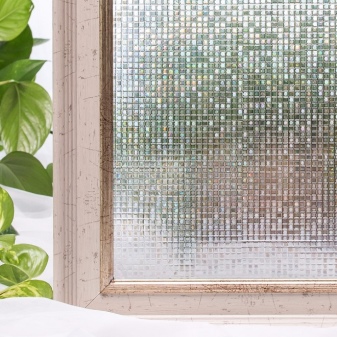

A light transparent shade will only not let the sun's rays through and is unlikely to cause rapturous glances.
- Stained glass with a picture. This method best mimics a stained glass window without damaging the window surface. The drawing can be very different: classic, geometric, childish (for example, with animals), with a plant theme, abstract. There are many styles for which stained glass with a pattern is appropriate: boho, eco, loft, classicism, English classics and others.


Each of these areas requires a certain design: for example, an image of leaves is suitable for eco, and red and yellow colors for the classics.
How to glue?
In general, the process of gluing the film is simple, but it has a number of nuances that you should familiarize yourself with. The most important thing is the surface treatment before starting the pasting. Usually, the films are sold with an adhesive layer, so there is no need to use additional glue.

Let's look at the step-by-step instructions.
- Surface cleaning. It is good if the surface on which you plan to apply the product is flat. In this case, it just needs to be cleaned of dirt and dust by walking with a damp cloth. Uneven surfaces need sanding, putty and primer. It is worth noting that the film will not hide all irregularities and flaws, but, on the contrary, will emphasize.
- Measurements. The next step will be to measure the surface on which it is planned to apply the film: whether it be a wall, a door or a window. It is recommended to mark the place of pasting with dots, making them with a pencil. With this method, the product will be precisely glued evenly.
- Film preparation. It is necessary to take a roll of film and cut off the required amount from it, leaving a margin of 2-3 cm. As a rule, there is a fine mesh on the reverse side of the product - it allows for even cutting.
- Sticker. Many people make one big mistake when pasting the surface, immediately tearing off the film. You don't need to do this. First, only part of the film is separated from the roll, glued gently to the surface, smoothed, and then moved on. It works according to a simple scheme - the film is glued from top to bottom, gradually it is smoothed so that bubbles do not form.

Advice! If bubbles appear on the film, do not be upset. The problem can be solved in the old, proven way - pierce the bubbles with a needle and smooth the film over the surface. This usually works.
Beautiful examples
Stained glass is a budget and fun way to transform a space. Beautiful examples prove this.
Stained glass is appropriate in almost any bedroom, as long as it matches the style of the room. The coating imitating a stained-glass window is a highlight and decoration of any room. It can be transparent, bright, patterned, and many other options.


The result is always amazing - just look at the spectacular photos to understand it. A wide selection of palettes and textures is the main advantage of a stained glass product. In addition, the material is of high quality and does not need additional maintenance after pasting.With the help of metallized film, visual effects are created: mirror, 3D-drawing, stained glass, which looks incomparable.



Do not forget that the concept of the room is important - it depends on how the film fits into the surrounding space. If the film is glued unevenly, it is possible to peel it off and re-glue it (there is no more than 12 hours for this after pasting, if the product is of high quality). Pasting takes no more than 30 minutes, and it is always better when two people work - one holds the roll, in the other glues the product evenly.


For information on how to glue Artscape stained glass, see the next video.













The comment was sent successfully.